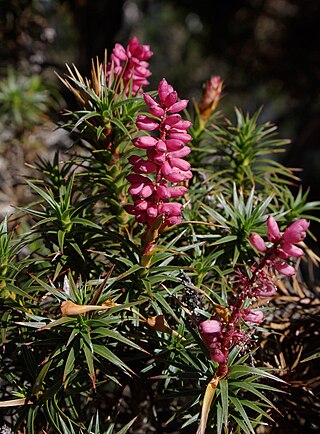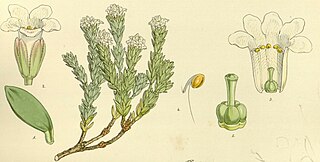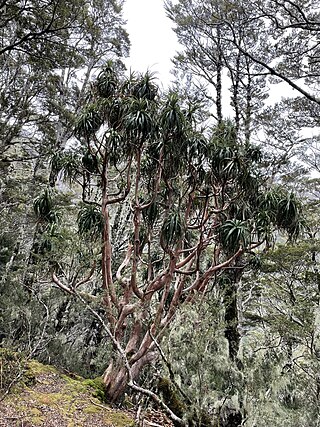
The Ericaceae are a family of flowering plants, commonly known as the heath or heather family, found most commonly in acidic and infertile growing conditions. The family is large, with c. 4250 known species spread across 124 genera, making it the 14th most species-rich family of flowering plants. The many well known and economically important members of the Ericaceae include the cranberry, blueberry, huckleberry, rhododendron, and various common heaths and heathers.

Epacris is a genus of about forty species of flowering plants in the family Ericaceae. It was formerly treated in a closely related but separate family Epacridaceae, but the various genera within Epacridaceae including Epacris have been revised in their relationships to each other and brought under the common umbrella of the Ericaceae. The genus Epacris is native to eastern and southeastern Australia, New Caledonia and New Zealand. The species are known as heaths or Australian heaths.

Dracophyllum is a genus of plants belonging to the family Ericaceae, formerly Epacridaceae. There are 61 species in the genus, mostly shrubs, but also cushion plants and trees, found in New Zealand, Australia, Lord Howe Island and New Caledonia. The name Dracophyllum, meaning dragon-leaf, refers to their strong outward similarity to the unrelated Dracaena, sometimes known as dragon tree. Although dicotyledonous, they resemble primitive monocots with their slender leaves concentrated in clumps at the ends of the branches; they are sometimes called grass-trees.
Rupicola is a small genus of flowering plants in the family Ericaceae. The species are endemic to New South Wales in Australia.

Leptecophylla is a genus of flowering plants in the Epacridaceae family, a subfamily of Ericaceae. The genus is native to southeastern Australia, New Zealand, Papua New Guinea and the Pacific Islands. Some species in this genus were formerly classified within the genera Cyathodes, Lissanthe, Styphelia and Trochocarpa.

Archeria traversii is a species of shrub in the family Ericaceae.

Richea scoparia is a species of plant endemic to Tasmania. The genus Richea, forms part of the Ericaceae family, which are commonly heath-like shrubs. The name refers to the erect bushy growth habit, described as a broom-like shrub, most commonly referred to as the honey bush or simply scoparia to many bushwalkers.

Dracophyllum milliganii is a species of angiosperm in the family Ericaceae and the sub-family Epacridoideae. It is a distinctive alpine shrub, endemic to western Tasmania.
Archeria comberi, also known as the pink mountain heath or comb heath, is a small, rare shrub endemic to Tasmania, Australia. As a member of the heath family, Ericaceae, this species is generally classified as a subalpine/ alpine species and shares many characteristics with other members of the family. It is an evergreen shrub 0.15m-1m in height, with pink flowers during the summer months, hence its common name pink mountain heath. Archeria comberi is often found growing among other species such as Nothofagus gunnii and Persoonia gunnii.

Archeria eriocarpa is a species of shrub in the family Ericaceae. It is endemic to Tasmania, Australia.

Archeria racemosa is a species of shrub in the family Ericaceae.

Archeria serpyllifolia is a dense, compact, low growing shrub, that is endemic to Tasmania, Australia, inhabiting the undisturbed alpine areas of southern and south-west Tasmania. This plant is commonly referred to by Australasian naturalists as thyme archeria.

Archeria hirtella is a species of shrub in the family Ericaceae. It is native to Tasmania, Australia.

Prionotes is a genus of flowering plants endemic to Tasmania, with a single species, Prionotes cerinthoides. Commonly known as climbing heath, it is a temperate rainforest climber or a small scrambling shrub in the mountains. It usually lives in very wet, undisturbed places.

Trochocarpa gunnii, commonly known as sweet-scented trochocarpa or fragrant purpleberry, is a common rainforest understorey shrub from the plant family Ericaceae endemic to Tasmania.

Dracophyllum traversii, commonly known as mountain neinei, grass tree, and pineapple tree is a species of flowering plant in the heath family Ericaceae. It is a deciduous tree endemic to New Zealand. It reaches a height of 0.2–13 m (0.66–42.65 ft) and has leaves which form tufts at the end of its branches. It has a lifespan of between 500 and 600 years.

Dracophyllum muscoides, commonly known as cushion inaka, is a small cushion plant in the family Ericaceae. It is endemic to New Zealand and is found only in the South Island in sub-alpine regions.

Dracophyllum menziesii, commonly known as pineapple scrub, is a species of shrub endemic to the South and Stewart Islands of New Zealand. In the heath family Ericaceae, it inhabits mountain slopes and cliffs from sea level up to 1,500 m (4,921 ft) and reaches a height of 0.5–1 m (1.6–3.3 ft). A 2017 assessment using the New Zealand Threat Classification System classified it as "Not Threatened," giving it an estimated population upwards of 100,000.

Leptecophylla parvifolia, commonly known as the mountain pinkberry, is a small to medium sized species of shrub in the family Ericaceae that is endemic to the highlands of Tasmania. This species was first collected and documented in 1804 by Robert Brown and was formerly included in the Cythodes genus. It was then as noted as subspecies of Leptecophylla junipernia but in 2018, was classified as its own species

Epacridoideae is a subfamily of the family Ericaceae. The name StyphelioideaeSweet is also used. The subfamily contains around 35 genera and 545 species. Many species are found in Australasia, others occurring northwards through the Pacific to Southeast Asia, with a small number in South America.
















